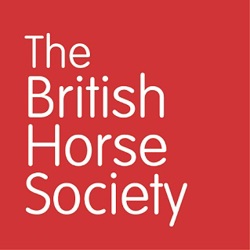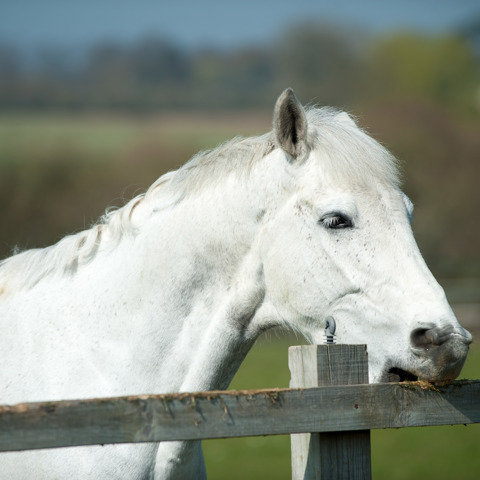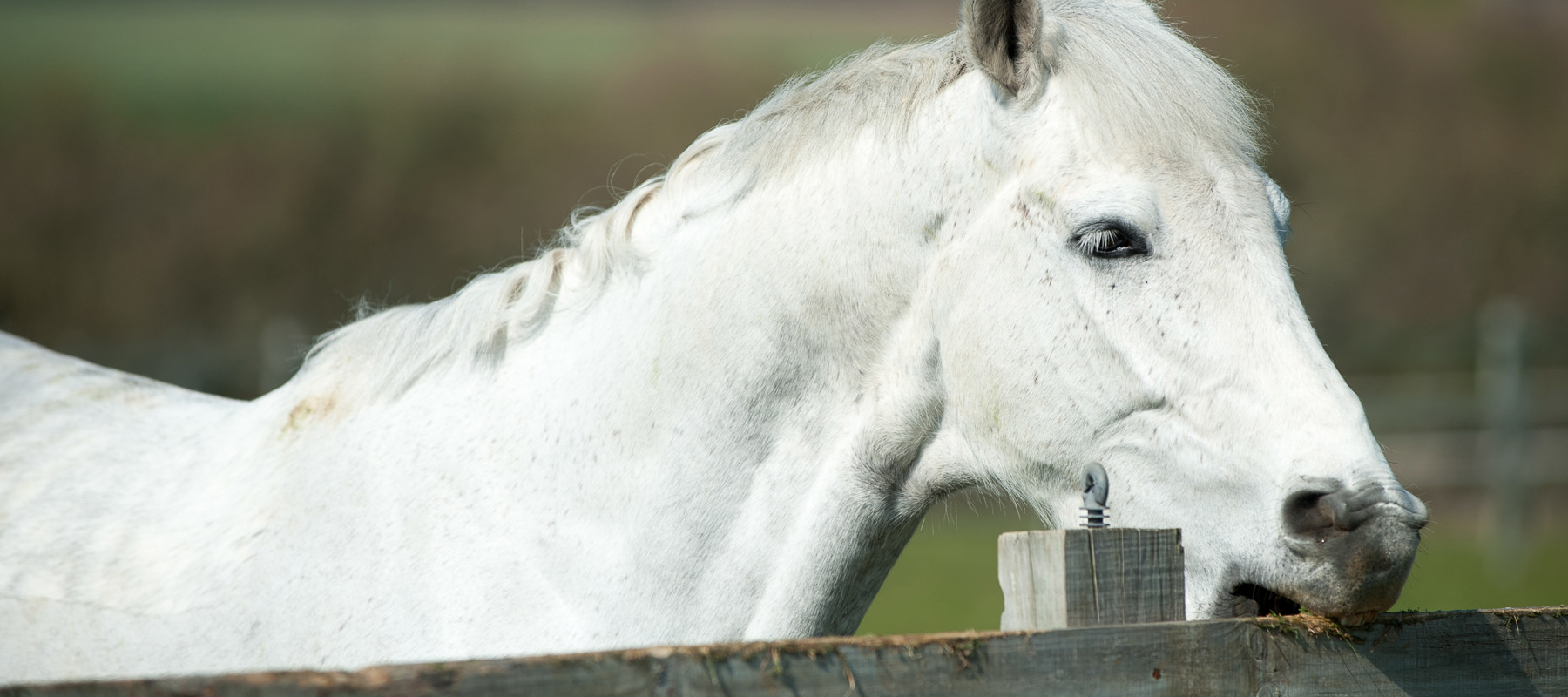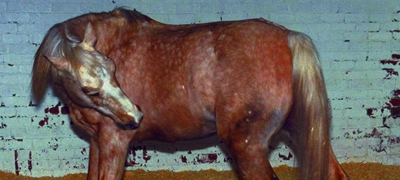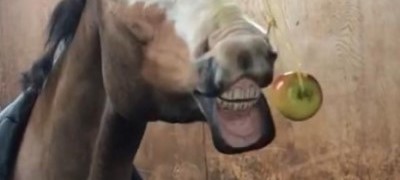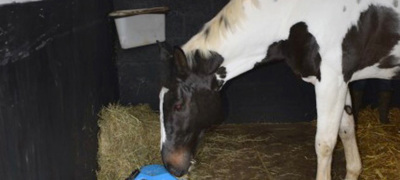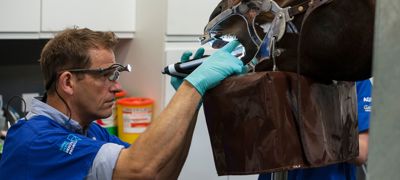Stereotypical behaviours often occur as a response to stress in their lives, for example a physical stress like gastric ulcers (pain related), or an environmental stress such as not being able to see other horses (anxiety).
Horses can develop stereotypies because of fear, frustration1, genetics, or due to a disorder of the nervous system2.
Behaviours that are reinforced and goal-directed are not stereotypies. For example, a horse repeatedly kicking the stable door at feed time suggests a learnt behaviour which is goal directed, as they attempt to hurry the arrival of their feed.
Common stereotypical behaviours
Oral
Crib Biting
chevron-down
chevron-up
This is when a horse is grasping a fixed object (usually a stable door or a fence) with their teeth and pulling back and also making a grunting noise as they gulp in air.
Wind Sucking
chevron-down
chevron-up
Wind sucking involves the horse arching its neck, opening their mouth and swallowing air, resulting in a gulping sound. It is similar to crib biting but does not involve the horse holding on to an object with their teeth.
Self-Mutilation
chevron-down
chevron-up
Patterns of behaviour expressed by repeatedly nipping at various areas of the body, stomping, or kicking against an object.
Locomotive
Weaving
chevron-down
chevron-up
Standing still, the horse will move their weight from one leg to the other while swinging their head and neck from side to side. Commonly seen over a stable door, although some horses may weave in any environment.
Box Walking
chevron-down
chevron-up
Walking repeated circuits of their stable or pacing back and forth. Usually, a result of anxiety due to a feeling of restriction in the stable or separation from other horses.
Head Tossing
chevron-down
chevron-up
When the horse is repeatedly throwing their head in an upwards motion. Usually seen as a sign of frustration.
How do stereotypical behaviours impact the horse?
The development of stereotypical behaviours has the potential to negatively impact the horse’s physical health, for example:
- An increased risk of colic (particularly with crib biting and wind sucking).
- Overdevelopment of particular muscles.
- Weight loss, as some would rather carry out their stereotypical behaviour than eat.
- Wearing down their teeth (crib biting).
- Increased strain on tendons and ligaments (weaving).
What causes stereotypical behaviours?
New behaviour patterns can indicate underlying health problems, so always speak with your vet if you spot the onset of any stereotypy.
If there are no physical causes, stereotypical behaviours are commonly linked to the horse’s environment and management. The modern-day management of horses is very different to how they evolved to live and can limit the horse’s ability to express natural behaviours such as, foraging, free exercise, mutual grooming or the experience of companionship in a social herd dynamic, potentially causing significant stress.
It is how the horse copes with this stress which will determine the likelihood of a stereotypical behaviour developing.
It is important to acknowledge that stereotypies do not always reflect the horse’s current living situation. These behaviours may initially develop as coping mechanisms when placed in an environment which does not meet the horse’s needs but, over time, the behaviour may develop into a habit which then continues to be displayed, even if they are moved into a suitable environment.
Management as a foal and through the weaning process plays a huge part in the development of stereotypical behaviours, with many stereotypies being established during the first nine months of life3.
For example, foals that are stabled throughout the weaning process and isolated from equines of a similar age, are much more likely to develop a stereotypical behaviour, then those turned out in a herd environment.
Horses that are restricted in their forage intake after weaning also have a greater risk of developing crib-biting than those that are not3.
Can stereotypical behaviours be copied?
Current research shows there is no evidence confirming that stereotypical behaviours can be developed just from one horse observing another4,5. It is therefore not advised to isolate horses showing stereotypical behaviours or keep them hidden from other horses at the fear of the behaviour being copied. If horses are isolated, you will be placing stress on the horse which may lead to the development of new stereotypical behaviours.
There have been reports of foals copying behaviours from dams, however the foal’s management and weaning regime are also important factors which must be considered in the development of stereotypical behaviours3.
Managing stereotypical behaviours
If after speaking with your vet, a physical cause has been found for your horse’s behaviour, this must first be addressed and managed appropriately.
Previous management of stereotypies focused physically stopping the behaviour through devices such as cribbing collars or anti-weave grills, and in some cases the complete isolation of the horse. These strategies do not address the root cause of the horse’s anxiety and can cause or exacerbate stress, potentially causing them to adapt their stereotypical behaviour or in some cases develop new ones.
The most effective method of managing stereotypical behaviours, and in turn improving your horse’s mental well-being and welfare, is through adapting their management. Focus on your horse’s day-to-day routine with the aim of encouraging natural behaviours and reducing levels of anxiety, stress, and frustration.
This can be achieved through:
Environment
chevron-down
chevron-up
Where possible, give your horse as much turnout as you can. If your horse is on a restricted diet, consider any safe alternative turnout options you could utilise.
For example, an arena, secured lunge pen, or if possible alternative grazing systems (pdf).
This provides your horse with the freedom to move, with other horses, while controlling their access to lower calorie forage.
If turn out becomes restricted on your yard (especially during the wet and muddy winter months) use different types of stable enrichment, aim to keep all horses in sight of each other and ensure your horse is taken out for daily exercise and hand grazing where possible.
Enrichment
chevron-down
chevron-up
Enrichment creates a greater variety and choice, and positively contributes towards the horse’s physical and mental needs, for example, by providing the opportunity for natural foraging behaviour when a horse is stabled.
The consumption of food can be slowed down with the use of certain products, such as the hay ball shown in the image below. This helps ensure the horse has more time eating rather than stood for long periods without forage or other forms of enrichment / attention. Read more about enrichment.
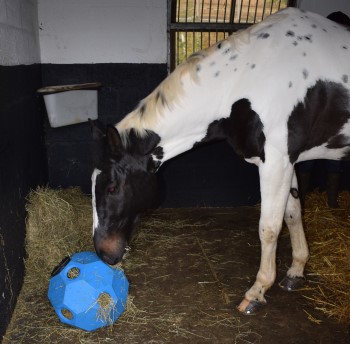
Companionship
chevron-down
chevron-up
Horses are social animals and being in a herd provides much needed companionship, security, and social behaviour.
If you are introducing your horse to a new herd, where facilities allow, turn them out in an empty neighbouring field, ensuring fencing is safe and secure. This will help to avoid conflict, prevent stress from bullying, and allows all horses to get used to each other safely.
Forage
chevron-down
chevron-up
Horses graze for up to 16 hours a day and have a natural desire to chew. Providing ad lib forage with multiple options and flavours will help meet this need, while increasing their time spent foraging6.
If your horse’s diet needs to be restricted, consider using small-holed hay nets to slow the rate of consumption, or incorporate a lower calorie forage, such as barley straw7, as part of your horse’s ration.
Always make these changes gradually and ensure your horse’s teeth are in good shape before introducing straw as it does take more chewing - this will also reduce the risk of colic.
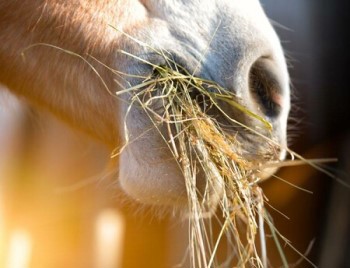
What if my horse is having to be isolated/is on box rest?
There may be circumstances where your horse has to be placed in isolation (due to disease prevention) or immediate box rest 24/7 due to veterinary advice. Although this may create a short-term stressor, it is important to focus on the long-term benefits.
To help provide the most natural environment for your horse in these situations you can still use some of the methods outlined above such as enrichment, forage and companionship - some yards operate a buddy system for box-rest horses, whereby field companions are used in a rota to be stabled next door to help provide company. You can also consider the following:
Exercise
chevron-down
chevron-up
Exercise - where possible, and if your horse is not on strict box rest, ensure they are taken out at least once daily, for either ridden or in hand work.
Turn out
chevron-down
chevron-up
Turn out - if your horse is having to be isolated, a separate area of grazing can be sectioned off, ensuring no nose-to-nose contact and a separate water supply.
Grooming
chevron-down
chevron-up
Grooming - mutual grooming is one of the most common social activities in horses. By taking the time to give your horse a good groom it helps to:
- Improve the human – horse bond
- Can lower the horse’s heart rate
- Increases blood flow to the skin’s surface
- Allows you to check for any lumps and bumps
Equine Behaviourists
If there has been no physical cause for concern from your vet regarding your horse’s behaviour, it may be beneficial to seek the help of a qualified equine behaviourist. They will aim to help you determine the reason behind a stereotypy and the motivation for your horse displaying the behaviour.
It’s important to remember that, although these behaviours may be minimised through a change in management, it is very unlikely that they will be eliminated altogether and that when placed back in a stressful environment the horse is likely to display the stereotypy more regularly. Learn more about equine behaviourists and find a practitioner.
References
chevron-down
chevron-up
1) Carroll, S, L. et al (2020) An online survey investigating perceived prevalence and treatment options for stereotypic behaviours in horses and undesirable behaviours associated with handling and riding. Equine Veterinary Education. 32(11), pp.71-81.
2) Roberts, K., et al. (2017). Causal factors of oral versus locomotor stereotypy in the horse. Journal of Veterinary Behaviour. 20, pp.37-43.
3) Waters, A, J. et al (2002) Factors influencing the development of stereotypic and redirected behaviours in young horses: findings of a four year prospective epidemiological study. Equine Veterinary Journal. 34(6), pp.572-9.
4) Rørvang, M, V et al (2018). Social Learning in Horses—Fact or Fiction? Frontiers Veterinary Science. 5, pp 212.
5) McBride, S. D. et al (2001) Management of horses showing stereotypic behaviour, owner perception and the implications for welfare
6) Hothersall, et al (2011). Undesired behaviour in horses: A review of their development, prevention, management and association with welfare. Equine Veterinary Education. 24(9). pp.479-485.
7) Dosi, MCM., et al (2020) Inducing weight loss in native ponies: is straw a viable alternative to hay? Veterinary Record 187, e60.
